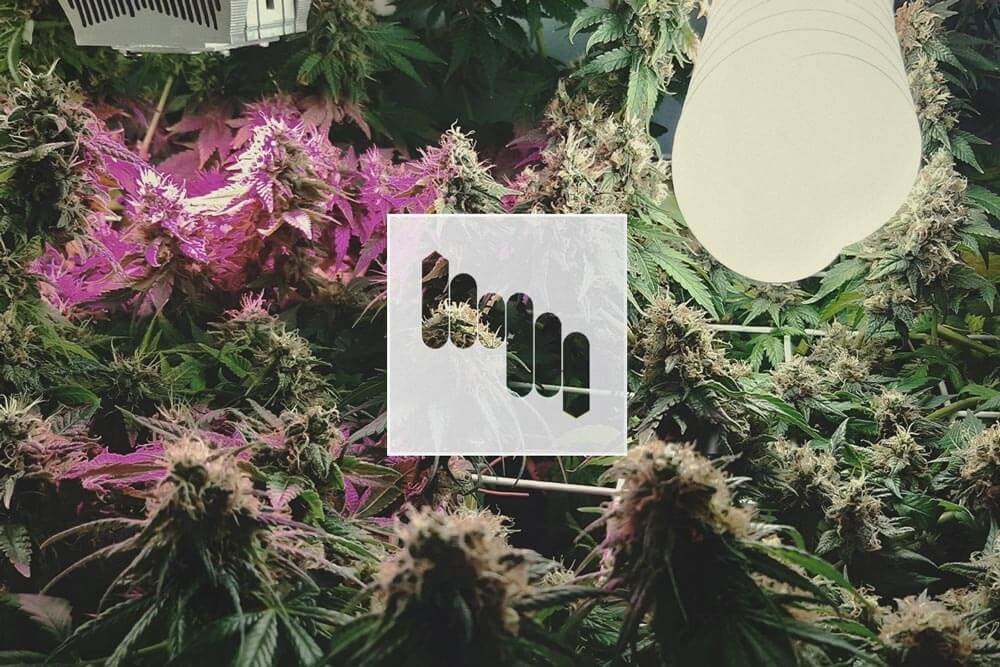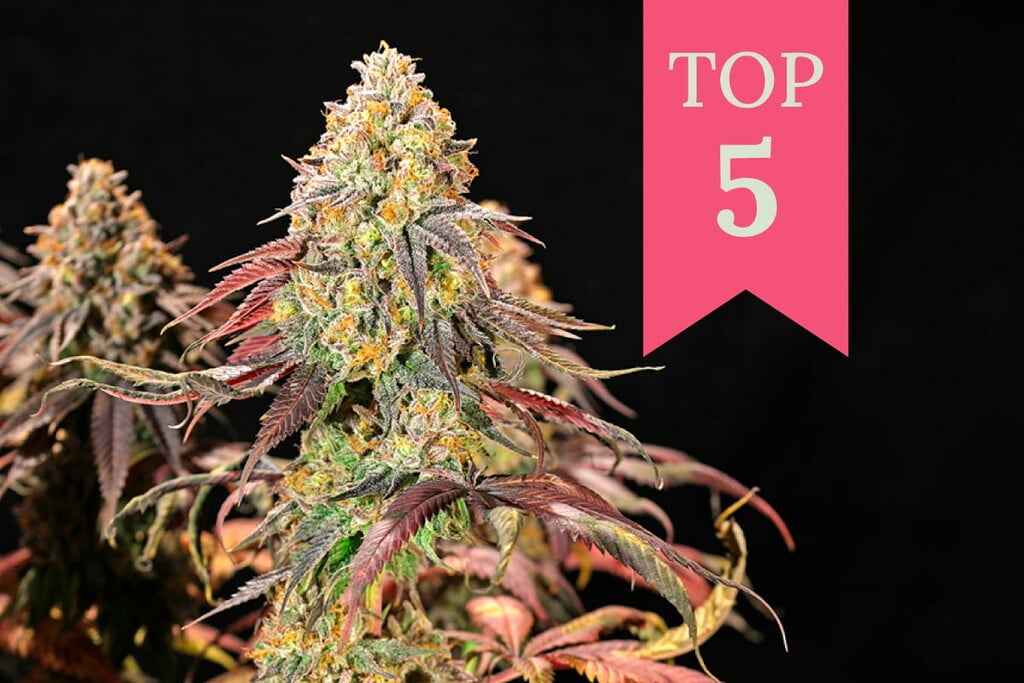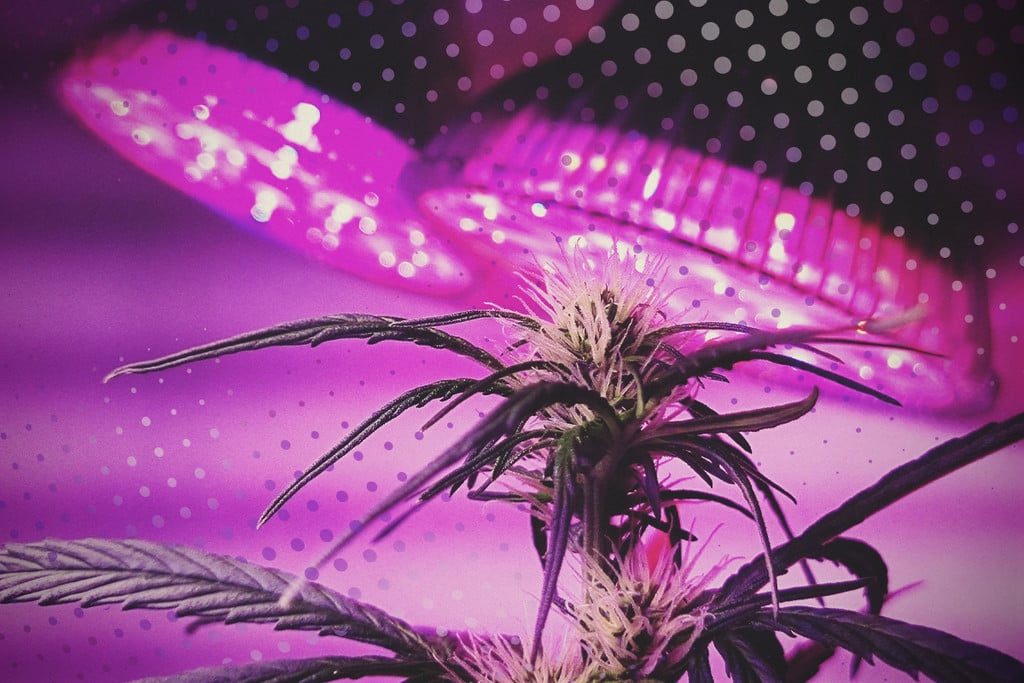 Weed Grow Guide by Royal Queen Seeds
Weed Grow Guide by Royal Queen Seeds
- Growing weed step by step
- Cannabis growing basics
- Choosing your seeds
- How to germinate seeds
- The cannabis vegetative stage
- The cannabis flowering stage
- Harvesting cannabis
- Trimming, drying, and curing
- Choosing pots and soil
-
Growing indoors
- A Complete Overview Of Growing Cannabis Indoors
- Cannabis Cultivation Tips: How To Set Up Indoor Grow Lights
- How Many Cannabis Plants Can You Grow Per Square Metre?
- Indoor Cannabis Growing: Relative Humidity and Temperatures
- Hydroponics Cannabis Growing Guide (with diagrams)
- Cannabis Micro Growing: Growing Great Weed in Tiny Spaces
- Growing outdoors
- How to grow autoflowering cannabis
- Cannabis nutrients and pH
- Cannabis troubleshooting: Nutrients
-
Cannabis troubleshooting: Growing
- Cannabis Seed Germination — Troubleshooting Guide
- How to Deal With Pythium (Root Rot) in Cannabis Plants
- Slow Cannabis Plant Growth And What You Can Do About It
- How to Deal With Leggy Cannabis Seedlings
- Watering Your Cannabis: How to Fix Overwatering and Underwatering
- Understanding Male, Female, And Hermaphrodite Cannabis
- Identifying and Treating Common Cannabis Ailments
- How To Revive a Sick Cannabis Plant
- How to Avoid Mouldy Weed During Drying and Curing
- How to Prevent and Treat Dry and Crispy Cannabis Leaves
- What Cannabis Leaves Can Tell You
- Causes and Solutions for Yellow Cannabis Leaves
-
Cannabis Strains Grow Report
- HulkBerry Automatic Grow Report
- Blue Cheese Auto Grow Report
- Purple Punch Automatic Strain Grow Report
- Triple G Automatic Grow Report
- Do-Si-Dos Automatic Grow Report
- Green Gelato Automatic Grow Report
- Haze Berry Automatic Grow Report
- Purple Queen Automatic Grow Report
- Cookies Gelato Automatic Grow Report
- Sherbet Queen Automatic Grow Report
- Sweet Skunk Automatic Grow Report
- Medusa F1 Grow Report
- Cannabis plant training
-
Weed growing tips
- The Cannabis Plant Anatomy
- How to preserve seeds - UK
- How Much Sunlight Do Outdoor Cannabis Plants Need To Grow?
- How to Control and Prevent Stretching in Cannabis Plants
- My Cannabis Plants Are Growing Too Tall: What Should I Do?
- Should You Worry About Purple Or Red Cannabis Stems?
- What To Do When Your Indoor Cannabis Won’t Flower
- How To Protect Your Cannabis Plants From Heat Stress
- How To Tell If Your Female Cannabis Plant Has Been Pollinated
- Growing Medical Marijuana
- Bud Washing: How to Clean Your Weed
- Understanding Cannabis Yield per Plant

Indoor Cannabis Growing: Relative Humidity and Temperatures
Contents:
Final results of an indoor grow are greatly influenced by the way growers keep in control of parameters that influence their plants growth. There are two basic factors that can easily be forgotten when we’re busy thinking of other ways to increase yields, size, and overall health of our plants – temperature & relative humidity. This blog summarizes ways to keep both of these factors within an optimum range, and provides specific information what conditions should be maintained to achieve best results.
HOW TEMPERATURES AND HUMIDITY LEVELS INTERACT
It’s important to know that humidity levels and temperatures are closely related to one another. When we talk about humidity, we usually mean relative humidity (RH), which is the ratio of partial pressure of water vapor to the maximum vapor pressure of water at the same temperature. You get the whole idea when knowing the basic principle that warm air holds more water vapor than cold air. This is one of the reasons why it’s necessary to extract a lot of warm air from our grow room, and ideally allow cool air to enter – warm air simply holds too much water vapor in it.
HUMIDITY LEVELS AND TEMPERATURES: FROM SEEDLING TO HARVEST
We need to define what humidity and temperature control actually means when growing cannabis. It makes sense to divide the life of cannabis plants into 4 different stages in which humidity levels, and temperatures, should be adjusted to ensure healthy growth. Don’t think that humidity and temperature control is complicated and not worth it! It’s generally very easy, and more about keeping parameters within a certain range, and as constant as possible.
The first thing you need to do is to buy a hygrometer and thermometer, preferably a digital one with memory function, also showing maximum and minimum values of the past. Some hygrometers aren't the most accurate, so don’t bother having several devices in your grow room to compare values. Now that we’re able to closely monitor our conditions, we can get to the essence of humidity and temperature control – the actual humidity levels and temperatures we aim for.
1. Seedling Stage
- Seedlings and clones like high humidity levels of 65-70%
- Reason: The root system is not established
- High humidity levels allow water intake through leaves
- Temperatures with lights on: 20-25 C° (lights off: 4-5 C° lower)

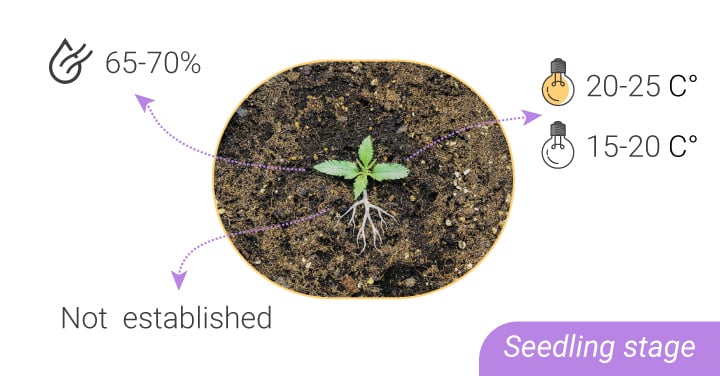
2. Vegetation Period
- Humidity levels can be lowered by 5% each week (acceptable range: 40-70%)
- Temperatures can be increased a little bit (no obligation)
- Reason: Roots absorb more water; evaporation through leaves cools plant(s)
- Temperatures with lights on: 22-28 C° (lights off: 4-5 C° lower)


3. Flowering Period
- Humidity levels need to be lowered to 40-50% (extremely important)
- You can get away with 55% (anything over 60% is real bad)
- It’s best to slightly lower temperatures in flowering
- Temperatures with lights on: 20-26 C° (avoid high temperatures)


4. Late flowering (1-2 weeks before harvest)
- The following steps are no necessity, but can improve yield, flavour and appearance
- Bring down humidity levels as much as you can: 30-40%
- Lower daytime temperatures, and also increase the temperature difference (day/night)
- Temperatures with lights on: 18-24 °C (lights off: minus 5-10 C°)


Starting your seeds off right is the foundation of a successful grow. Download our beginner’s guide to learn how to germinate, care for seedlings, and prepare for healthy growth.
Free RQS
Grow Guide!

ADJUSTING HUMIDITY LEVELS AND TEMPERATURES
We’ve got a pretty good idea on humidity levels and temperatures we aim for. Now it’s time to get to the practical part, and to find ways to bring things back in balance when they’re not. Most growers will struggle to keep both relative humidity and temperatures down, which is of primary importance in the flowering period – we got that. In some colder regions, and depending on the lighting solution, the opposite scenario might be the case, and temperatures or humidity levels must be raised.
Remember the basic principle that warm air holds more water than cold air? Keep this in mind, and be aware of the fact that relative humidity and temperatures interact with one another.
A. WAYS TO LOWER HUMIDITY
- Run you existing tube vent on higher velocities or upgrade (air exits tent AND the room it is placed in!)
- Increase fresh/cool air supply (e.g. active air intake by 140mm case fans for PC’s)
- Try to water your plants right after lights are switched on
- Spend money on a decent sized dehumidifier (the small ones can’t hold enough water)

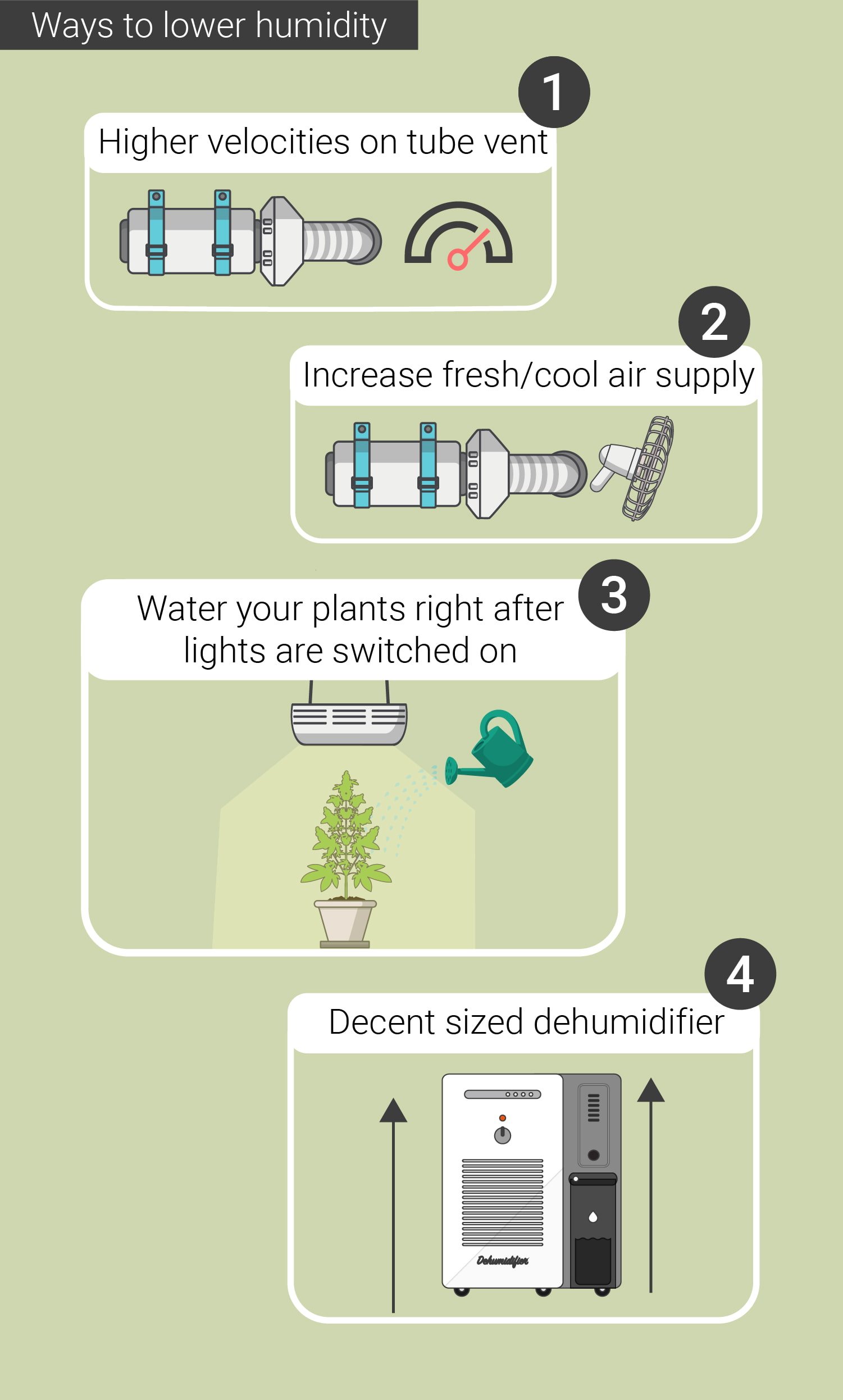
B. WAYS TO LOWER TEMPERATURES
- Just like lowering humidity: Increase the total airflow in your room by allowing more warm air to be extracted, and more cool air to enter (higher velocities or bigger tube vent)
- Always have “lights off” during the day, and “lights on” at night
- When you grow with HPS lights, consider using a cooltube
- Install an air conditioning unit (AC’s will also lower humidity levels)

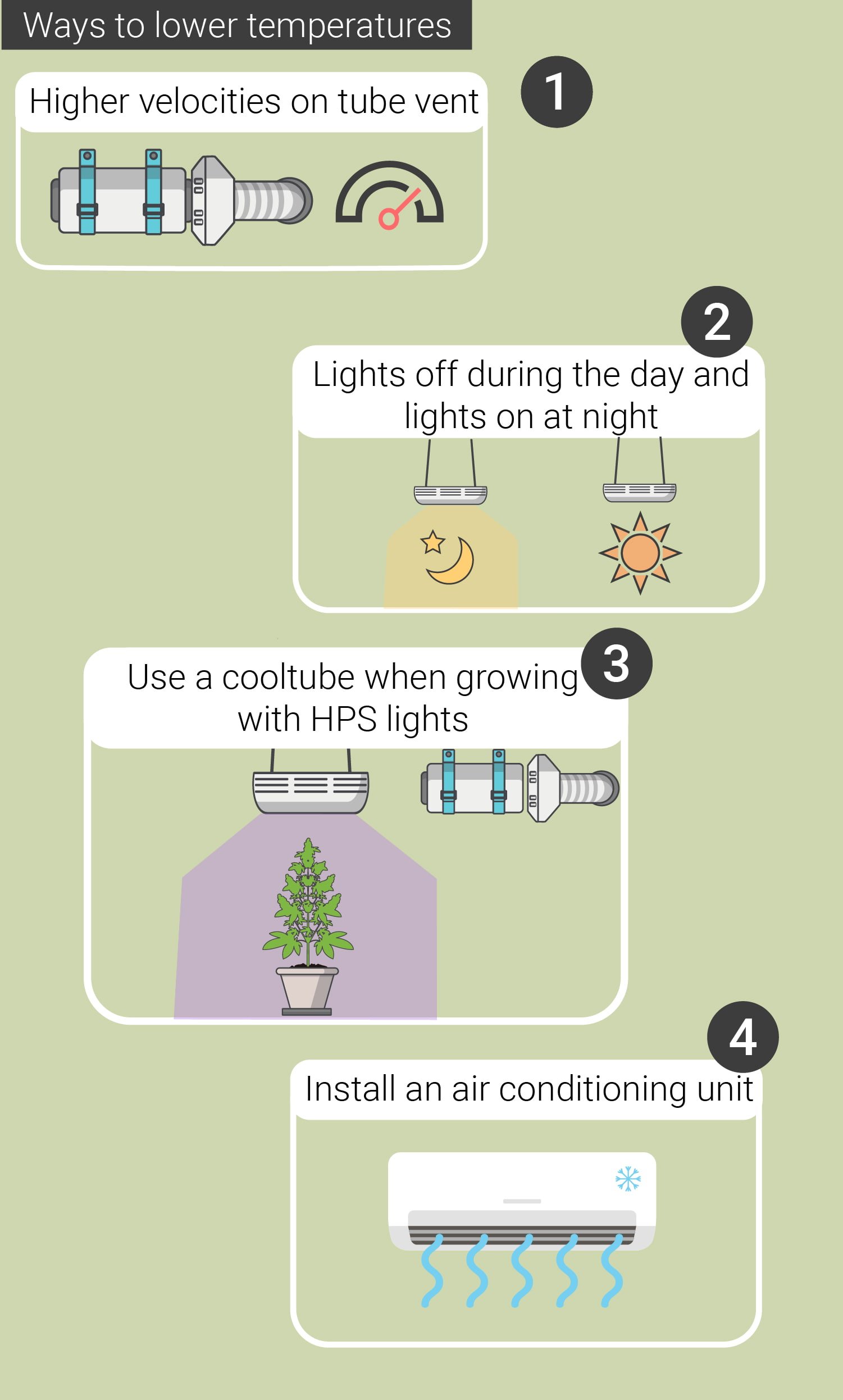
C. RAISING HUMIDITY
- Manually increase humidity levels with a spray bottle (It won’t last long)
- Keep the surface of the soil moist, but not wet
- Hang wet towels/cloths in your grow room or put open water containers in it
- Invest money in a humidifier with a large water tank (small ones demand constant refills)
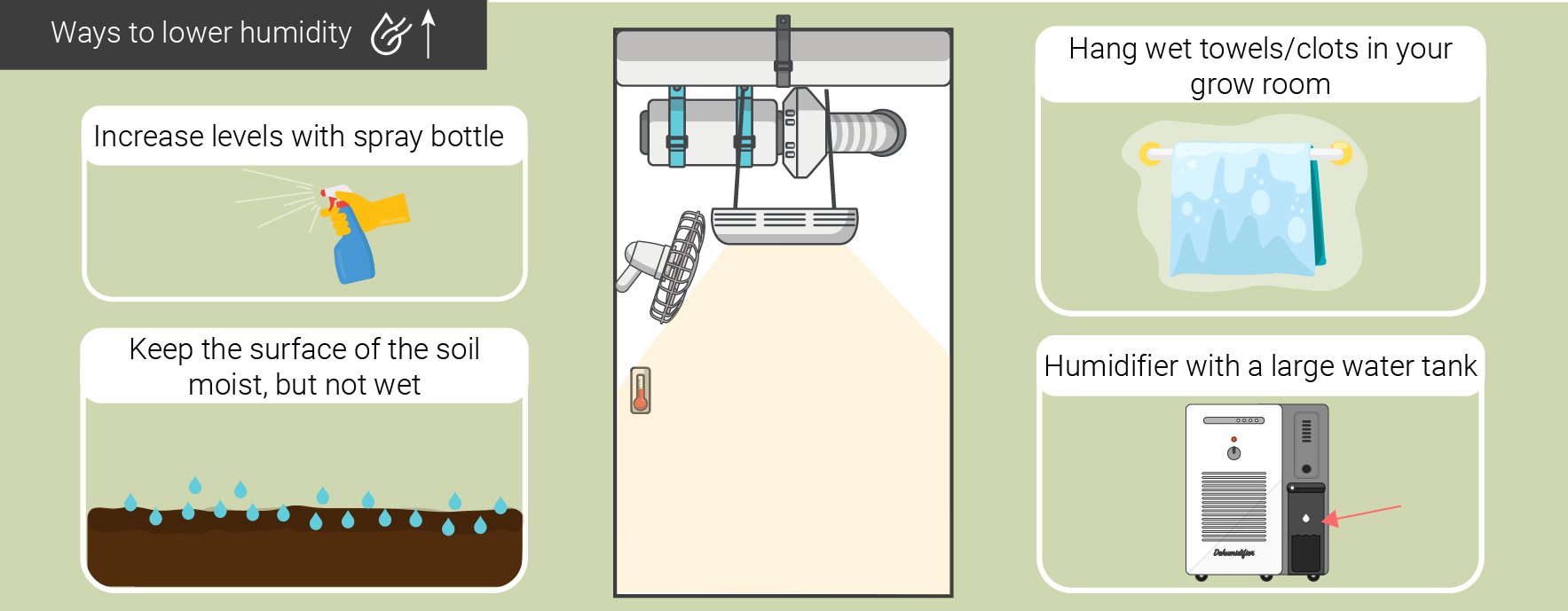

D. RAISING TEMPERATURES
- You can always upgrade to a bigger grow light (more watts = more heat)
- Place a heating mat at the bottom of your tent or grow room
- Isolate your grow room with materials from the hardware shop
- Use a simple space heater with a thermostat

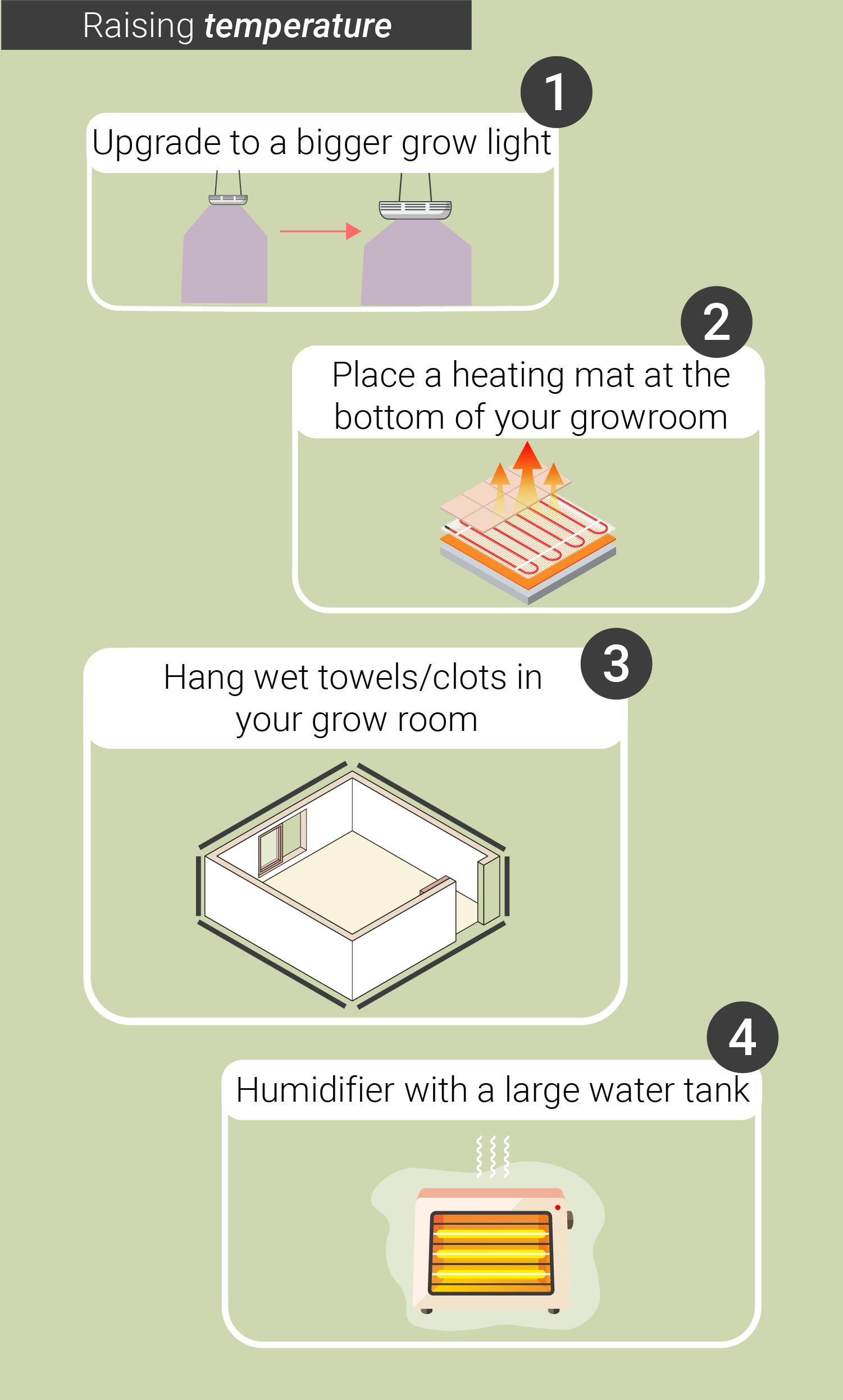
 Grow Guide Topic Finder
Grow Guide Topic Finder
- Growing weed step by step
- Cannabis growing basics
- Choosing your seeds
- How to germinate seeds
- The cannabis vegetative stage
- The cannabis flowering stage
- Harvesting cannabis
- Trimming, drying, and curing
- Choosing pots and soil
-
Growing indoors
- A Complete Overview Of Growing Cannabis Indoors
- Cannabis Cultivation Tips: How To Set Up Indoor Grow Lights
- How Many Cannabis Plants Can You Grow Per Square Metre?
- Indoor Cannabis Growing: Relative Humidity and Temperatures
- Hydroponics Cannabis Growing Guide (with diagrams)
- Cannabis Micro Growing: Growing Great Weed in Tiny Spaces
- Growing outdoors
- How to grow autoflowering cannabis
- Cannabis nutrients and pH
- Cannabis troubleshooting: Nutrients
-
Cannabis troubleshooting: Growing
- Cannabis Seed Germination — Troubleshooting Guide
- How to Deal With Pythium (Root Rot) in Cannabis Plants
- Slow Cannabis Plant Growth And What You Can Do About It
- How to Deal With Leggy Cannabis Seedlings
- Watering Your Cannabis: How to Fix Overwatering and Underwatering
- Understanding Male, Female, And Hermaphrodite Cannabis
- Identifying and Treating Common Cannabis Ailments
- How To Revive a Sick Cannabis Plant
- How to Avoid Mouldy Weed During Drying and Curing
- How to Prevent and Treat Dry and Crispy Cannabis Leaves
- What Cannabis Leaves Can Tell You
- Causes and Solutions for Yellow Cannabis Leaves
-
Cannabis Strains Grow Report
- HulkBerry Automatic Grow Report
- Blue Cheese Auto Grow Report
- Purple Punch Automatic Strain Grow Report
- Triple G Automatic Grow Report
- Do-Si-Dos Automatic Grow Report
- Green Gelato Automatic Grow Report
- Haze Berry Automatic Grow Report
- Purple Queen Automatic Grow Report
- Cookies Gelato Automatic Grow Report
- Sherbet Queen Automatic Grow Report
- Sweet Skunk Automatic Grow Report
- Medusa F1 Grow Report
- Cannabis plant training
-
Weed growing tips
- The Cannabis Plant Anatomy
- How to preserve seeds - UK
- How Much Sunlight Do Outdoor Cannabis Plants Need To Grow?
- How to Control and Prevent Stretching in Cannabis Plants
- My Cannabis Plants Are Growing Too Tall: What Should I Do?
- Should You Worry About Purple Or Red Cannabis Stems?
- What To Do When Your Indoor Cannabis Won’t Flower
- How To Protect Your Cannabis Plants From Heat Stress
- How To Tell If Your Female Cannabis Plant Has Been Pollinated
- Growing Medical Marijuana
- Bud Washing: How to Clean Your Weed
- Understanding Cannabis Yield per Plant




























